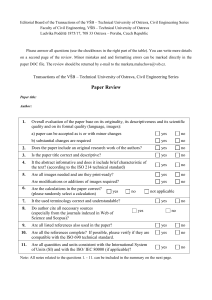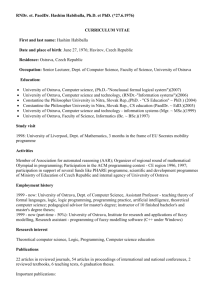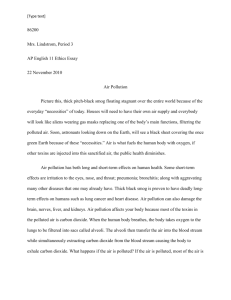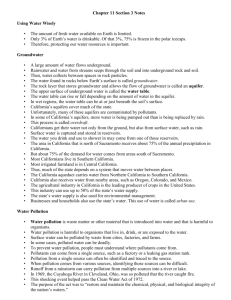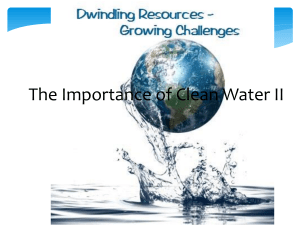Environment protection
advertisement
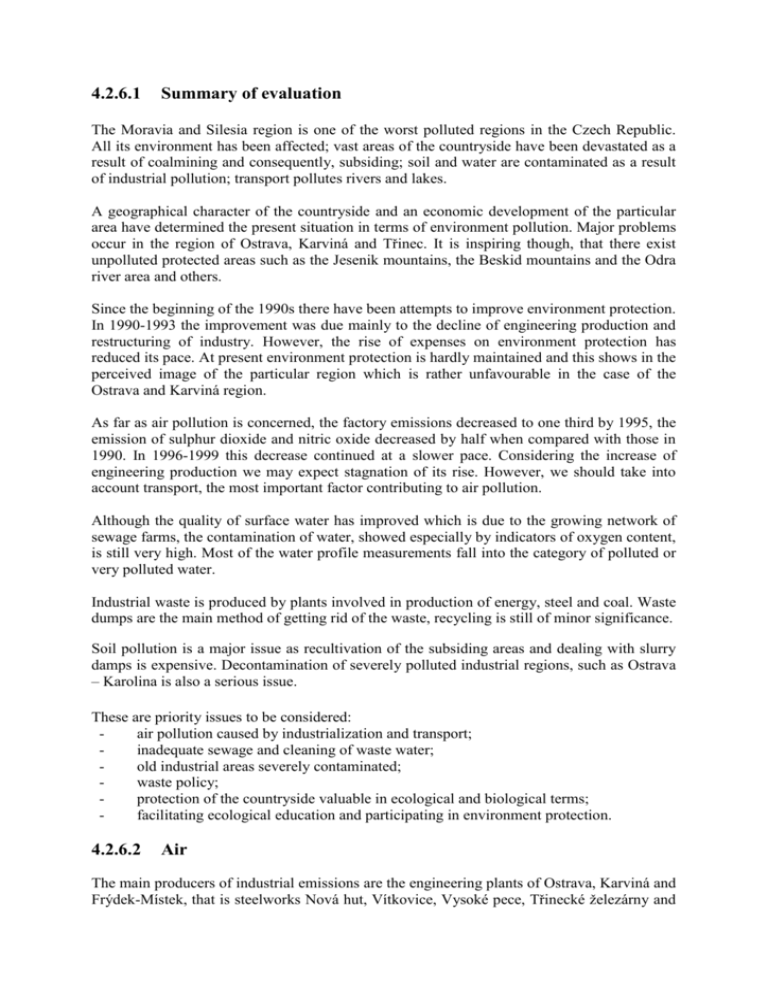
4.2.6.1 Summary of evaluation The Moravia and Silesia region is one of the worst polluted regions in the Czech Republic. All its environment has been affected; vast areas of the countryside have been devastated as a result of coalmining and consequently, subsiding; soil and water are contaminated as a result of industrial pollution; transport pollutes rivers and lakes. A geographical character of the countryside and an economic development of the particular area have determined the present situation in terms of environment pollution. Major problems occur in the region of Ostrava, Karviná and Třinec. It is inspiring though, that there exist unpolluted protected areas such as the Jesenik mountains, the Beskid mountains and the Odra river area and others. Since the beginning of the 1990s there have been attempts to improve environment protection. In 1990-1993 the improvement was due mainly to the decline of engineering production and restructuring of industry. However, the rise of expenses on environment protection has reduced its pace. At present environment protection is hardly maintained and this shows in the perceived image of the particular region which is rather unfavourable in the case of the Ostrava and Karviná region. As far as air pollution is concerned, the factory emissions decreased to one third by 1995, the emission of sulphur dioxide and nitric oxide decreased by half when compared with those in 1990. In 1996-1999 this decrease continued at a slower pace. Considering the increase of engineering production we may expect stagnation of its rise. However, we should take into account transport, the most important factor contributing to air pollution. Although the quality of surface water has improved which is due to the growing network of sewage farms, the contamination of water, showed especially by indicators of oxygen content, is still very high. Most of the water profile measurements fall into the category of polluted or very polluted water. Industrial waste is produced by plants involved in production of energy, steel and coal. Waste dumps are the main method of getting rid of the waste, recycling is still of minor significance. Soil pollution is a major issue as recultivation of the subsiding areas and dealing with slurry damps is expensive. Decontamination of severely polluted industrial regions, such as Ostrava – Karolina is also a serious issue. These are priority issues to be considered: air pollution caused by industrialization and transport; inadequate sewage and cleaning of waste water; old industrial areas severely contaminated; waste policy; protection of the countryside valuable in ecological and biological terms; facilitating ecological education and participating in environment protection. 4.2.6.2 Air The main producers of industrial emissions are the engineering plants of Ostrava, Karviná and Frýdek-Místek, that is steelworks Nová hut, Vítkovice, Vysoké pece, Třinecké železárny and Dětmarovice power plant. Emissions produced by heating houses also contribute significantly to pollution, especially during inversion they may become a major factor of air pollution. The tendency of pollution decrease caused by stationary sources is shown below. The decrease is due to the reconstructing, closing of steelworks and progress in introducing gaspipe network. Year 1996 1999 N.B. - Solid waste 27.6 8.8 SO2 77.3 33.7 NOx 36.8 24.9 CO 255.6 151.6 CxHy 11.8 6.0 amounts are in kt in a year these items are issued by the Regional Centre of Ministry of Environment, for the Moravia and Silesia Region and the District of Vsetín The Moravia and Silesia Region comes second in the emission of nitric oxide and comes third in the emission of sulphur dioxide. According to numbers of 1998 both Ostrava nad Karviná districts produce 70 per cent of sulphur dioxide emissions, that is 47.4% and 20.2% respectively. As far as nitric oxide is concerned, these districts produce respectively 49.1% and 25.7% of this gas. Pollution is being monitored permanently by 55 stations in the whole region, out of which 30 of them belong to the Czech Hydrometheorologic Institute. Another major institution that runs 10 stations is the Hygienic Istitute. Road transport proves to show a stable increase of environment polluting, which is due to the growth of car ownership. The maximum growth of transport occurs in Ostrava where the Opavská road is especially busy; it scores 41,000 vehicles per day. 4.2.6.3 Water Water management in this region is important as a number of huge industrial aglomerations are in need of water. There are a few major accumulation dams; eg in Slezská Harta, Moravka, Žermanice, Těrlicko and Šance. Karviná and Nový Jičín districts abound in a functional systems of ponds. The quality of water is still a major issue even if a lot has been improved. According to oxygen indicators the region, 70% of water falls into the category of seriously polluted water. Less than 9% of the measurements fall into the category of the worst polluted water. Indicators concerning biological and microbiological pollution show that the situation is really serious. A minor improvement is due to the newly established sewage farms built in Karviná and Ostrava districts. Fragility of the region in terms of being flooded is a serious issue, with the latest most serious flood taking place in 1997. There are three natural reservoirs of underground water, that is in the mountains of Jeseniky, Beskid, and the Jablunkov area. Districts of Nový Jičín, Opava and Bruntal abound in the mineral water resources. 4.2.6.4 Waste The main producers of industrial waste are the steelwork, power, coalmining and coke plants. The waste structure has not changed much. Waste has been put into waste dumps. Its burning is still restricted by law. The cases of burning of industrial waste in Ostrava as well as community waste in the cement plants are exceptional. A gradual abandonment of recycling of plastic packaging is an unfavourable development in community waste recycling. In 1999 the Morava and Silesia region produced 10,611 kt of waste and 1,525 kt of dangerous waste. Ostrava district produced respectively 1,523 and 494 kt of waste; Karviná district produced 4,736 and 543 kt in the particular waste categories. Slurry from sewage farms is the main issue in waste management, followed by organic waste and the increasing amount of plastic waste. The problem of illegal waste dumps is still to be solved. 4.2.6.5 Ecological burden Closed waste dumps that do not comply with the contemporary requirements and ecologically dangerous plants that were privatized are the issues to be considered. The significant activities to be taken up are removal of slurry and gradual recultivation of slurry damps that were byproducts of coal preparation in Karviná district. Another important activity is recultivation of the areas devastated by coalmining activities. Decontamination of the area of the closed coke plant Karolina in the centre of Ostrava is a major project that will make it possible to enlarge the city centre. This project needs at least 1.5 billion crowns from the State Environmental Fund. At present a vast decontamination is being caried out in seven places of the region. An analysis of risk taking of cleaning is being prepared for other 10 areas. A similar analysis is carried out for the Vítkovice plant. The preparation activities are getting faster, yet the whole process is time-consuming and the actions take time (eg. Lagoon Ostramo). New investors are willing to come and build new plants „from scratch”. Abandonment of old plants is to be considered a negative aspect of this development as „brownfields” of this kind prevent a reasonable use of the area. A specific element in the old industrial areas is a danger of methane emission as the old coalmines might be still endangering their neighbourhood and these places have not been mapped yet. This kind of danger has increased in the Ostrava area as the result of the fast closing of coalmines and it is being solved by increased monitoring. 4.2.6.6 Rock and soil environment Coal mining in the area of Ostrava, Karviná and Frýdek Místek is the main factor determining a vast devastation of the country. The effects of coal mining activities are demonstrated best in a map of subsiding lands in the Czech Republic and in Poland. The effects of coal mining on the environment are of a local character in most cases, such as output of gravel or ground rock. Bruntál district is an exception to this, where the output of the ore is taking place. Longlasting deposit of heterogenous substances influences the quality of the soil in the region. Holistic screening evaluation of the district soil contamination has not been carried out; nevertheless, contamination by polyaromatic carbon oxides was proved in the region of Ostrava; the soil in the area of Frýdek Místek was found to be contaminated by cadmium and nickel and Nový Jičín district contains lead. 4.2.6.7 Major technical problems It is estimated that the following major technical problems concern the environment: air pollution in the area of the sources of contamination; removal of repercussions of 1997 floods, i.e. provision of anti-erosion measures and provision against landslide; inadequate water cleaning provision for security of old mines in terms of their underground as well as prevention of gas emission devastation of mines and slow elimination of the existing damage; dealing with old ecological damage caused by opening and closed industrial plants; recultivating and securing of waste dumps. 4.2.6.8 Environmental education Enviromental education has not been supported systematically, and this is demonstrated by generally low level of awareness of environment protection and insufficient participation in dealing with current issues concerning environment. This situation might potentially bring about possible problems when implementing international undertakings (Aarhus Convention) or when implementing EU environmental legislature (concerning citizens’ participation). Voluntary undertakings of the environmental management system in the business sector – according to the norms of ČSN EN ISO 14 000, EMAS – are applied only to a limited degree. Regional industrial and enviromental agency commenced its functioning aimed primarily at small and medium enterprises. 4.2.6.9 Costs of improving the quality of life environment The funds for carrying out environmental projects were aimed mainly at infrastructure of urban projects and at dealing with long-existing ecological problems. Financing of the ecological projects is shared by districts, various business enterprises and also by the State Fund of Environment Protection, which spends approximately half million crowns per year. Ecological issues that were brought about by mining activities were financed obligatorily by the mining plant of the Ostrava-Karviná region. The particular cases were subsidized by the state funds. The amount of the expenses has been falling recently and comes to about 340 million crowns.
